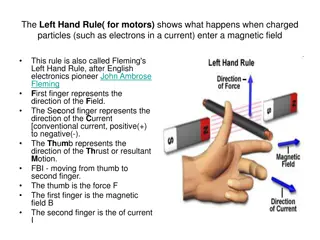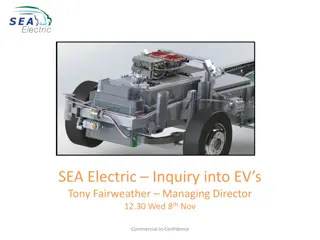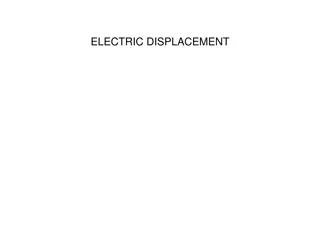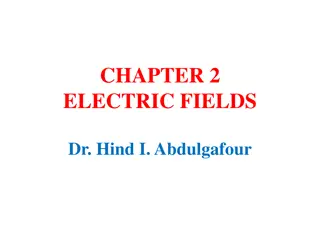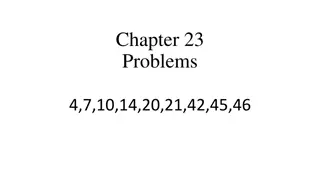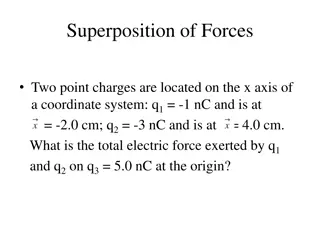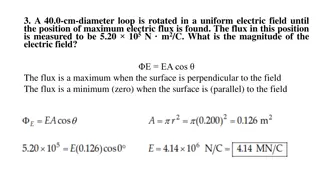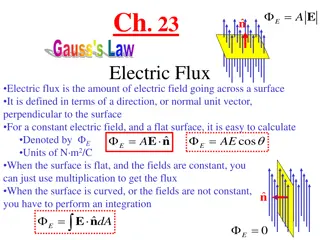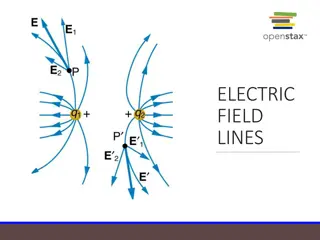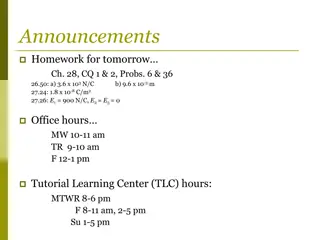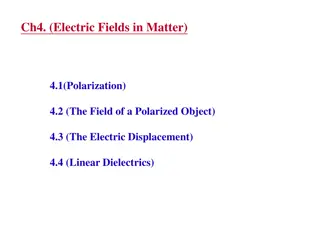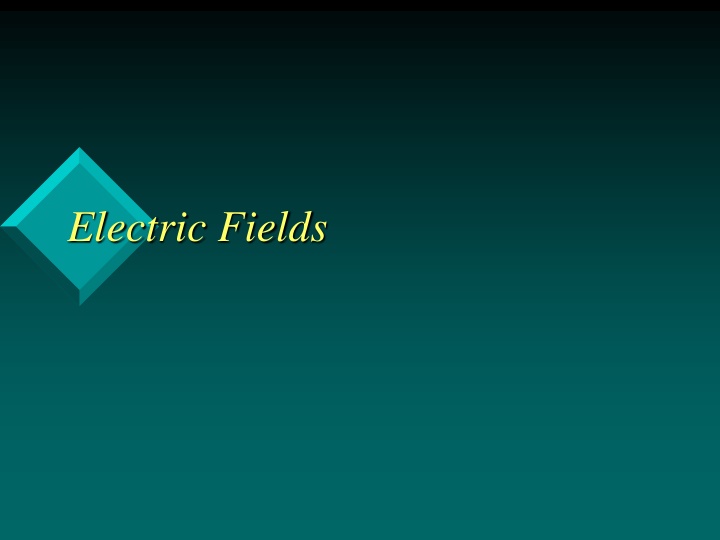
Understanding Electric Fields and Test Charges
Explore the concept of electric fields, force fields, and test charges. Discover how electric fields affect charged particles and learn about Coulomb's Law and gravitational force fields. Dive into examples to deepen your understanding.
Download Presentation

Please find below an Image/Link to download the presentation.
The content on the website is provided AS IS for your information and personal use only. It may not be sold, licensed, or shared on other websites without obtaining consent from the author. If you encounter any issues during the download, it is possible that the publisher has removed the file from their server.
You are allowed to download the files provided on this website for personal or commercial use, subject to the condition that they are used lawfully. All files are the property of their respective owners.
The content on the website is provided AS IS for your information and personal use only. It may not be sold, licensed, or shared on other websites without obtaining consent from the author.
E N D
Presentation Transcript
What is an Electric Field? An electric field is a force field. An electric field is a vector quantity. An electric field provides the direction that a positive test charge will move if placed in the field. An electric field is composed of a series of imaginary lines of force.
What you already know Newton s Universal Law of Gravitation: ??=???? ?2 Satellite ?? Note: Gravity is always attractive.
What you already know Coulomb s Law: kqq = Fe 2 r Positive Test Charge + F qo q Note: qo is much smaller than q!
What are Force Fields? Force fields exert forces on objects under their influence. Gravitational Force Field: ? ??? ?2 ? =?? ??=???? ??= ? ??= ? ? ?2 ? From the equation, a gravitational force field is a measure of the force per unit of mass, or N/kg. ? Electric Force Field: ?? ?2 ? =?? ??=???? ??= ?? ??= ??? ?2 ?? From the equation, an electric force field is a measure of the force per unit of charge, or N/C.
Electric Field The electric field is the electrostatic force that a positive test charge experiences divided by itself. ???? ?2 ?? ??=?? ??=?? ??= ?2 ?? P + r E Fe +qo q Note: The electric field is a vector quantity and has the same direction as the force that would act on a positively charged test particle.
What is the Test Charge It is small enough that it does not affect the field due to other charged objects. It will experience a repulsive or attractive force depending on whether it is charged similarly or dissimilarly from other objects. + F F +qo -qo Q
The Test Charge (Cont.) F +qo _ _ _ + + _ _ + + _ _ + + + + + _ _ _ +qo F _ _ + + _ + _ _ + + _ _ + + _ + _ + Test Charge moves away from a positively charged object Test Charge moves towards a negatively charged object Negatively Charged Object Positively Charged Object
Example 1: A positive charge of 4.0 x 10-5 C at point P experiences a force of 0.36 N at this location. What is the electric field intensity at point P? P qo = 4.0 x 10-5C, Fe = 0.36 N E = Fe/qo E = 0.36 N / 4.0 x 10-5C E = 9000 N/C + Fe E +qo Q Note: The electric field intensity says nothing about the magnitude of charge Q, which is the source of the electric field that produces the force that charge qo experiences.
Electric Field Lines Electric field lines, or lines of force, provide a map of the electric field at any point in space relative to a charge or a group of charges. Electric field lines show the path that a positive test charge would take if placed in the field. F _ _ _ + + _ _ +qo + + _ _ + + + + + _ _ _ _ _ + + _ + _ _ + + _ _ + + _ + _ +
- + Electric Field Lines Electric field lines begin at positive charges and are always directed away from them towards negative charges. Electric field lines do not start or stop except at the surfaces of positive or negative charges. Electric field lines are always perpendicular (90 ) to the surface where they start or end. Electric field lines never cross. The strength of the field is proportional to the magnitude of the charge and is directly related to the density of field lines the more lines there are and the closer together they are, the stronger the field.
Electric Field Lines Due to a Point Charge Direction of field is away from the positive charge. Density of lines is highest close to the surface of the charged object and decreases radially outward. + + + + + + + + + + + + + + + + + + Lines intersect the surface of a charged particle at right angles. Positive Charge
Electric Field Strength and Distance for Point Charges For point charges: The strength of the field decreases as the distance increases. Weak Field ? =?? + +++ + + + + + + ?? + + + + ++ ? =?? + + ?2 Strong Field
? = ? ? Example 2: ?? In example No. 1, you found the electric field intensity at some arbitrary point P in space knowing the charge (4.0 x 10-5 C) of the particle and the force(0.36 N) it experienced. If the value of r is 100 m, what is the magnitude of the charge that was the source the electric field? E at point P is 9000 N/C P From before: ?? ?? ? = + r F qo 0.36? 4.0 10 5? ? = 9000?/? Q ? =
E = 9000 N/C Everywhere along this arc. Example 2: + r Fe qo ? = ? ? Q ?? (??? ?)? ?.?? ???? ?? ? = ? ?? ?= ?,???? = 0.010 C ? ??
Electric Fields and Conductors E At equilibrium, excess charges will reside on the surface of a conductor. The electric field is zero at any point within a conducting material at equilibrium. Charge within a conductor is shielded from external electric fields because they begin or terminate on the surface where excess charges reside. ++ ++ ++ ++ + + + + ++ + + + + No E-Field inside conductor Faraday s Cage
Note: An electric dipole consists of two charges equal in magnitude and opposite in sign. Electric Dipole F -Q +Q +qo _ _ _ _ _ + + _ + _ + _ _ + _ + + + + _ _ _ + + _ + _ _ + + _ _ + + _ + + Note: Force on a test charge(qo) is always tangent the field lines, and is the vector sum of the forces due to both charges of the dipole acting on it.
Parallel Plate Capacitor The parallel plate capacitor is an energy storage device used in all kinds of electronics. Field lines in a parallel plate capacitor are evenly spaced and parallel to one another, indicating a uniform electric field. - - - - - - - - + + + + + + + + E
Electrostatic Force and Distance For parallel plates: The strength of the field is constant from one plate to the other. Since E does not vary, the force will be constant. - - - - - - - - - - - - - - - - - - - - - - - - - - - - - - - - + + + + + + + + + + + + + + + + + + + + + + + + + + + + + + + + = E E F q E ?? e o
Force and Electric Field Strength vs. Distance Point Charge Parallel Plate ??=???? Force Force ??= ??? ?2 Distance Distance Field Intensity Field Intensity ? =?? ? =?? ?2 ?? Distance Distance
Example (Millikan Oil Drop Exp.) An oil drop is negatively charged and weighs 8.5 x 10-14 N. The drop is suspended in an electric field intensity of 5.3 x 101 N/C. + + + + + + What is the charge on the drop? Fe = Eq How many electrons is that? ~10,000 electrons Since Fnet = 0N, Fe = Fg Eq = mg q = mg/E = Fg/E q = 8.5 x 10-14 N/53 N/C q = 1.6 x 10-15C - Fg = mg E - - - - - -
Draw the electric field lines for the following configurations. + + + + + + + + + - - - - - - - - - - + - - -
Examples from the Web http://www.cco.caltech.edu/~phys1/java/phys1/EField/EField.html http://phet.colorado.edu/sims/charges-and-fields/charges-and-fields_en.html
Key Ideas Electric fields exists around any conductor or insulator that contains a charge. The electric field intensity is a measure of the force on a test charge placed in the field. The strength of the field is proportional to the density of field lines. Field lines are perpendicular to all charged surfaces. The electric field is always directed away from positive charges and towards negative charges.



